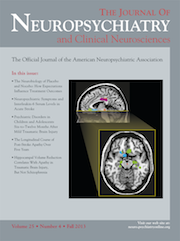Reduction in White Matter Before and After the Development of Delusions of Theft in a Patient With Alzheimer Disease
To the Editor: A recent study1 has suggested that white-matter (WM) lesions in Alzheimer disease (AD) patients are associated with delusions. Diffusion tensor imaging (DTI) is an important tool for detecting degradations in fractional anisotropy (FA) associated with WM lesions.2 However, whether FA results change before or after the onset of delusions in AD patients is unclear. Here, we report on a patient with AD who developed delusions of theft and exhibited a reduction in FA over 2 years.
Case Report
The patient was a 66-year-old, married, right-handed woman. At the age of 63 years, she exhibited progressive memory loss. At the age of 66, she visited our hospital with her family. An initial T1-weighted magnetic resonance imaging (MRI) examination revealed moderate bilateral medial temporal atrophy (MTA), with no other abnormal findings. Her Mini-Mental State Exam (MMSE) score was 20/30. Based on a detailed examination, she was clinically diagnosed with probable AD. On her first visit to our hospital, she did not show any type of psychotic symptoms. She had no previous history of psychiatric disease. She was given a prescription for donepezil (5 mg/day). One year later, she began to exhibit delusions of theft, saying that her friends had stolen her money. Risperidone (maximum dose, 2.0 mg/day) did not diminish her delusions. She refused to take any other antipsychotic medications. During the following 6-month period, her delusions of theft became more marked. Two years after her first visit, she was admitted to a psychiatric hospital. At this time, a second MRI revealed the progression of bilateral MTA, but no other additional findings.
DTI data were obtained twice, at the same time as the T1-weighted MRI examination. DTI data processing was performed, using the software Dr. View 5.0 (Asahi Kasei Joho System, Co., Ltd., Tokyo, Japan). FA was measured in different regions of the WM, using ROIs according to a protocol.3 Among several regions (genu of the corpus callosum [GCC], splenium of the corpus callosum, peri-callosal areas, etc.), a significant reduction in the FA value, relative to the value in AD patients without delusions (N=15), was only observed in the GCC on both occasions. The reduction in the FA value in the GCC over the 2-year period in this case was 33%, whereas the corresponding reduction in the FA value in the AD patients without psychosis was 13% (see Table 1).
| Present Case | AD Patients Without Delusion (N=15) | |
|---|---|---|
| Baseline | 0.612 | 0.705 (0.291) |
| Follow-up (2 years after baseline) | 0.410 | 0.610 (0.131) |
| Reduction of FA value, % | 33 | 13 |
Discussion
To the best of our knowledge, this is the first case of reduction in WM structures before and after development of delusions in AD patients. The GCC is known as a highly organized region, located at the midline areas of the CC.3 FA reductions in the GCC may reflect the breakdown of connectivity between bilateral frontal lobes, resulting in the development of delusions. Our case suggested that AD patients who develop delusions may have vulnerable WM structures in the GCC, and rapid changes in this area are associated with the appearance of delusions. Further longitudinal, large-sample studies of AD patients who develop delusions may support this hypothesis.
1 : Association between subcortical lesions and behavioral and psychological symptoms in patients with Alzheimer’s disease. Dement Geriatr Cogn Disord 2011; 32:417–423Crossref, Medline, Google Scholar
2 : DTI analyses and clinical applications in Alzheimer’s disease. J Alzheimers Dis 2011; 26(Suppl 3):287–296Crossref, Medline, Google Scholar
3 : White-matter damage in Alzheimer disease and mild cognitive impairment: assessment with diffusion-tensor MR imaging and parallel imaging techniques. Radiology 2007; 243:483–492Crossref, Medline, Google Scholar



